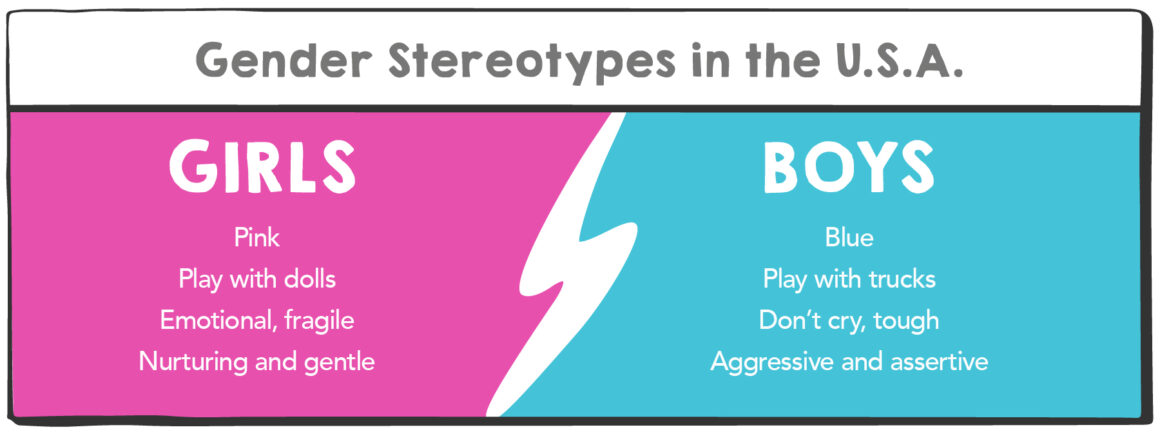A guide to understanding and deconstructing gender roles and stereotypes.
Author Jen Bell | Reviewed by Mason Dunn
Do you believe that some activities are “only for girls” and some “only for boys”? Or do you find yourself thinking something is cute when it’s pink and has flowers, and handsome when it is blue? Where do you think these ideas come from?
Each culture has its own gender expectations. These include how to act, talk, dress, feel emotion, and interact with other people. In the U.S. there are traditionally very defined gender roles that describe what it means to be a boy or a girl, or masculine and feminine. We learn what’s expected of us at a very early age from our caregivers, family, friends, culture, religion, media, and movies.
What Are Gender Roles?

Gender roles are stereotypes or preconceived notions that a society puts on a certain gender. For example, in the U.S., a gender stereotype might be that girls like to play with dolls, must be gentle and nurturing, and must love the color pink. On the other hand, a gender stereotype about boys might be that they love the color blue, like trucks and cars, never cry, and must be assertive and aggressive to be successful.
Masculinity, or attributes characteristic to being a “man” or “boy,” and femininity, or attributes characteristic to being a “woman” or “girl,” are equated with certain physical attributes, labeling us as more or less of a “real” man or woman based on how our bodies look.
This gendering of our bodies, as well as societal gender roles and stereotypes, affect how we feel about ourselves, and how others perceive and interact with us.
What Is Toxic Masculinity?
Toxic masculinity is a term to describe cultural pressures put on men and boys to behave in a certain “manly” way: by being tough, aggressive, power-hungry, and by rejecting anything deemed “feminine,” such as showing emotion or accepting help.
Not only is toxic masculinity harmful to boys and men, it is damaging for everyone else as well. Just as toxic masculinity can encourage unhealthy behaviours such as heavy drinking and smoking and discouraging men from taking care of their mental and physical health, it is also linked to gender-based violence, sexual assault, and gun violence.

Whatever your gender, if you feel like you’re experiencing the negative effects of toxic masculinity and are ready to address that, seek assistance, like support groups or a behavioral health clinician.
How Do Cultural & Societal Influences Affect Our Understanding of Gender?
So much of how we experience our gender, and how others interact with us is based on all of our intersecting identities. Things like our ethnicity, family dynamics, religion, skin color, language(s) we speak, and so much more play a huge role in how we experience our gender.
Two people might each identify as nonbinary but have very different experiences because of their language and family culture. One family might show love and support in very different ways compared to another family, and that’s OK!
Often conversations about gender come from a very white perspective. It’s important to amplify stories about gender that capture how diverse the world is, and how complex many of our identities are.
Our Understanding of Gender Is Always Changing
Norms relating to gender change across societies and over time. Before the 1950s, pink was seen as a color for boys, and blue was for girls. Today, it’s becoming more and more normal to see gender neutral baby clothing in the store and gender-inclusive or gender-neutral clothing and sizing.
Some recent stats:
- A 2017 survey published by GLAAD found that 12% of US millennials identify as transgender or gender non-conforming — approximately one person in eight.
- Further, according to research by Wunderman Thompson, 56% of U.S. youth aged 13 to 20 know someone who uses gender-neutral pronouns (such as they/them).
Imagine how our understanding of gender could change in the next 20 years!
Tools To Help Deconstruct & Help Your Understanding of Gender
Many adults find that taking the time to assess their own beliefs about gender helps them to be more open and understanding with the children and teens in their lives. We recommend these tools:
My Gender Journey
Gender Spectrum has created My Gender Journey, an online exercise to help parents, caregivers, and professionals to reflect on the ways that gender expectations have influenced our relationships, education, career, and other aspects of our lives.
- My Gender Journey – for Parents and Adult Family Members
- My Gender Journey – for Professionals who work with children or families
My New Gender Workbook
My New Gender Workbook by Kate Bornstein, is a fun and provocative book that examines gender in light of issues like race, class, sexuality, and language, and offers quizzes, puzzles, and exercises to help the reader challenge and question their own ideas and assumptions about gender.
